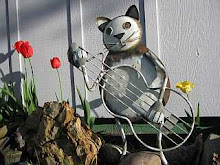I now have a tractor so I looked in earnest for hay. The closest I found hay was near Browning, MT just east of the mountains. More hay was available farther away but having hay hauled in on a semi also meant paying shipping. Shipping runs $4 to $5 a mile. Ya... that can add up quickly over the miles.
Talking on the phone with the Browning rancher selling the hay I had a good 'vibe' so I order a semi load of hay.
His semi hauls 30 large round bales: 16 bales on the bottom and 14 bales on a second row on top. The bales are suppose to weigh 1200 lbs to 1300+ lbs which works out to be about 18 to 20 tons of hay. He charges $4 a mile to haul hay. Between the cost of the hay and the cost to haul the hay, a semi load of hay for me cost $4000.
I didn't need the hay right away and we both wanted to avoid the rain in the forecast. Lots of rain and he couldn't get his semi in the field to load the hay, and after the rain quit it would take a day for the field to dry before he could load. When the forecast looked right he would load his semi the afternoon/evening before and call me to tell me he would be coming the next morning.
With the forecast I didn't expect the hay until Sunday or Monday but Thursday night was rain free for him (not me) and Friday morning looked good for both of us. I got a call late Thursday night.
Okay... but I had something to do before he arrived. A semi truck cannot turn into my driveway or the two separate gates along the road to the fields. The plan was for the semi to come through my neighbor's property (as he has a large driveway that semis have driven on in the past, and gave me permission to use) and then through my fence onto my property.
Well... not exactly "through" my fence. I would cut an opening in the fence. My plans were to do so and put a 16 ft gate there for this semi and any future semis or large trucks. But.... this busy Summer I had not gotten around to putting a gate in yet. Now this would be a quick cut in the fence to make an opening large enough for a semi to drive through.
The rancher called 7:30 am in the morning when he left and I had a little over two hours to make an opening. I did. My neighbor came outside and helped me.
Due to a stack of long metal pieces on the neighbor's side of the opening the area was only about 11 ft - just enough for the semi to squeeze through. It did. The pine tree on the left was brushed by the semi.
 |
| After the semi left I placed two corral panels over the opening in the fence. |

I went to work with my tractor. First I moved my existing four bales out of the way. In doing so I backed into a post by the gate to the north pasture. I had planned on replacing the post with a railroad tie - next year. Now I will be replacing the post this year - the sooner the better.
The tractor seller was correct in saying the tractor's tires had ballast in them. The tractor's loader could just reach the top bales. A few times I lowered the bales rather fast and had to quickly stop before the bale reached the ground. The tractor bounced a bit but did not tip forward.
The rancher was an older man, chatty like me, and quite knowledgeable about hay and cattle. We talked for quite a bit before he went on his way. Being from east of the mountains he drives a large tractor. My tractor is a lower mid sized tractor. Several times the rancher referred to my tractor as a little tractor.
The hay is a alfalfa/orchard grass mix. It looks to be the best hay I have ever bought.
Below... part of the reason for high cattle prices.... $4000 worth of hay. And this is about 3/5's of what the cattle will need over Winter.





No comments:
Post a Comment